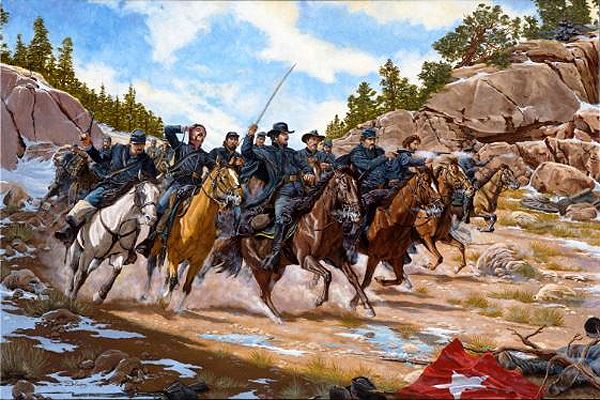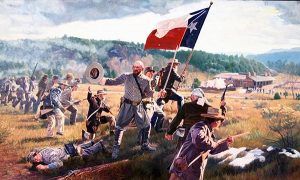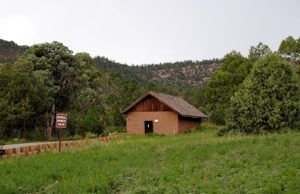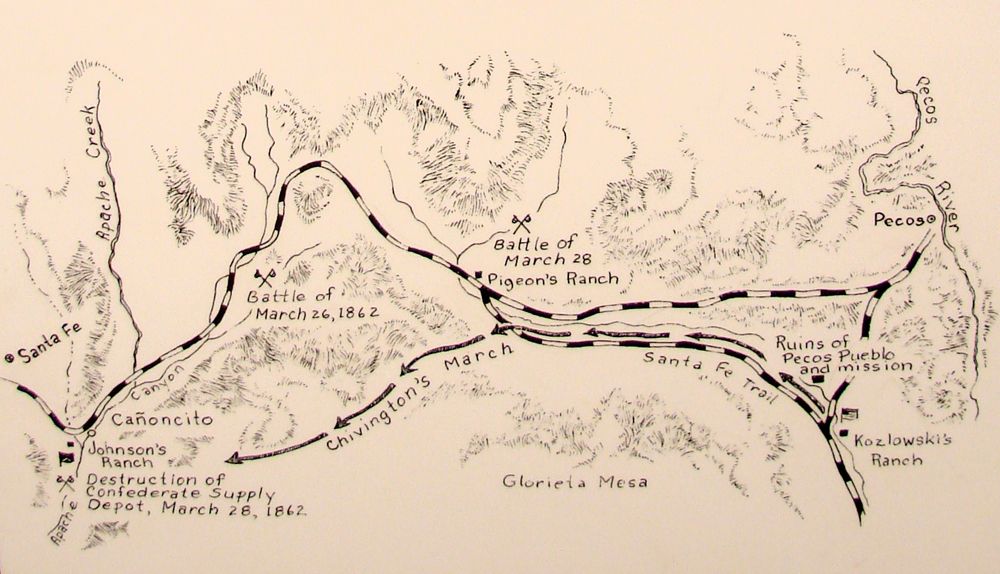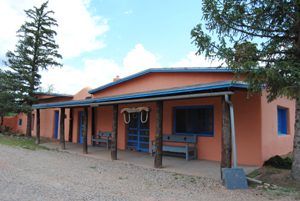Battle of Glorieta Pass, New Mexico – Legends of America (original) (raw)
Battle of Glorieta Pass, New Mexico
The Confederate plan for the West during the Civil War was to raise a force in Texas, march up the Rio Grande, take Santa Fe, turn northeast on the Santa Fe Trail, capture the stores at Fort Union, head up to Colorado to capture the gold fields and then turn west to take California.
New Mexico, Utah, and Colorado were “giant recruiting grounds” for potential enlistees to the Southern cause. All three states had populations loyal to the Confederacy, and southern New Mexico had already effectively seceded from the government at Santa Fe and formed a separate territory all the way to California.
War materials in New Mexico were rumored to be extensive (6,000-8,000 rifles and 25-30 cannons), and the morale of the Federal troops guarding the territory was said to be abysmal. The capture of these territories would mean more wealth for the Confederacy from the rich mines of Colorado. Slavery could be expanded, especially into fertile California, and Arizona could be used as a springboard to invade Mexico. Perhaps most important, there would be access to 1,200 miles of California coastline with many open, blockade-free ports. Open trading ports meant a better chance of recognition and trading with European countries.
In 1861, Confederate President Jefferson Davis commissioned General Henry Hopkins Sibley to raise three full regiments in West Texas, which eventually became the Fourth, Fifth, and Seventh Texas Volunteer Cavalry. By late Fall 1861, there were 3,500 men prepared to invade New Mexico.
Led by Confederate Brigadier General Henry Hopkins Sibley, southern troops invaded northern New Mexico Territory beginning in February 1862 to gain control of the Southwest and the gold fields of Colorado and the ports of California. One of the most ambitious Confederate campaigns of the Trans-Mississippi Theater, the rebels hoped to establish control of the American West and to open an additional theater in the war.
After the Confederates claimed victory in the Battle of Valverde in February 1862, they began to move towards Santa Fe.
Civil War Battle at Pigeon’s Ranch, 1862
Union and Confederate forces met at Apache Pass, about 10 miles to the southeast of Santa Fe, on March 26, 1862. A strategic location, situated at the southern tip of the Sangre de Cristo Mountains on the Santa Fe Trail, Union troops came into contact with a Confederate force of 200-300 Texans under the command of Major Charles L. Pyron, who were encamped at Johnson’s Ranch, at one end of the pass. Union Major John M. Chivington led more than 400 soldiers on the morning of the 26th in an attack, capturing some Confederate advance troops before finding the main force behind them. Chivington advanced on them, but their artillery fire threw him back. He regrouped, split his force to the two sides of the pass, caught the Rebels in a crossfire, and soon forced them to retire.
Pigeon’s Ranch, Glorieta Pass, New Mexico by Kathy Alexander.
Pyron and his men then retreated about a mile and a half to a narrow section of the pass and formed a defensive line before Chivington’s men appeared. The Union troops then flanked Pyron’s men again, firing heavily into their ranks. When the Confederates fled again, the Union cavalry charged, capturing the Confederate rearguard. Chivington then retired and went into camp at Kozlowski’s Ranch. No fighting occurred the next day as reinforcements arrived for both sides. Lieutenant Colonel William R. Scurry’s troops swelled the Rebel ranks to about 1,100 while Union Colonel John P. Slough arrived with about 900 men.
Both Slough and Scurry decided to attack early on March 28th. As Scurry advanced down the canyon, he saw the Union forces approaching, so he established a battle line, including his dismounted cavalry. Slough hit them before 11:00 am. The Confederates held their ground and then attacked and counterattacked throughout the afternoon. The fighting then ended as Slough retired first to Pigeon’s Ranch and then to Kozlowski’s Ranch.
Battle of Glorieta Pass Map
Scurry soon left the field also, thinking he had won the battle. Chivington’s men, in the meantime, had destroyed all Scurry’s supplies and animals at Johnson’s Ranch, which forced him to retreat to Santa Fe, the first step on the long road back to San Antonio, Texas. The Battle of Glorieta Pass was the turning point of the war in New Mexico Territory. In the end, it resulted in 331 total casualties – 142 Union and 189 Confederate.
The Confederates then moved southward again to Albuquerque to find Edward Canby, recently promoted to brigadier general for the Union, outside the town with 1,200 men. Facing defeat and starvation, Sibley and his men began their retreat to Texas. They were pursued to Fort Craig by Canby’s troops but, finally slipped from the Federals by a circuitous route. Nearly dead of thirst and starvation, 1,700 Confederate survivors eventually reached safety in El Paso, Texas, on May 4th.
By July 1862, all Confederate Troops had vacated New Mexico Territory, and for the duration of the Civil War, New Mexico remained under Union control.
Kozlowski Stage Stop, Pecos National Park, New Mexico by Kathy Alexander.
Had the Confederates been successful in this campaign, it would have denied the Union a major source of the gold and silver necessary to finance its war effort. Additionally, the Union Navy would have had the additional difficulty of attempting to blockade several hundred miles of coastline in the Pacific.
Compiled and edited by Kathy Weiser/Legends of America, updated May 2021.
Also See:
